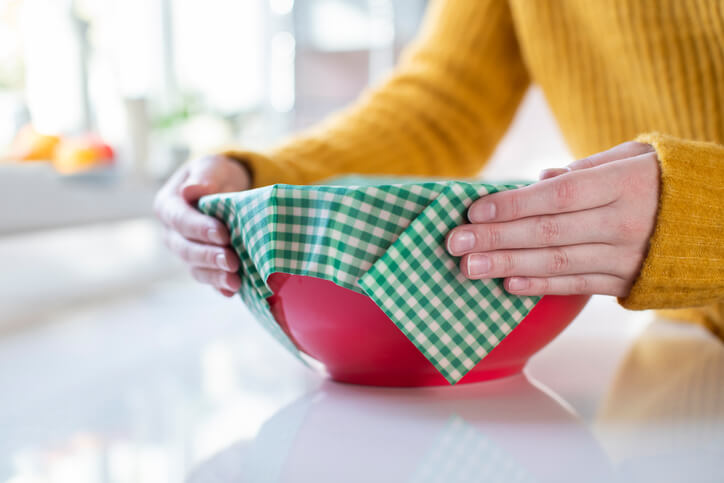Are you interested in finding out how to reduce your environmental footprint? Or, at least how to have less trash each week? If so, start at home.
The Environmental Protection Agency (EPA) defines trash, or municipal solid waste, as things people throw away after they’ve used them. That includes food waste, product packaging, and even household goods, like old furniture or broken appliances.
Each family and household is different, but if you’re anything like the average American, you get heavy use out of your trash can. In fact, Americans produced 292.4 million tons of municipal solid waste in 2018, according to the latest report by the EPA.
One of the easiest ways to lower your impact on the environment is to reduce the amount of waste your family generates. While some households strive for a completely zero-waste lifestyle, this may require such drastic changes that you end up facing a family mutiny. Luckily, you’ll still find many easy ways to make improvements and reduce your household waste without dramatically changing your lifestyle. And these gentle changes should be sustainable every day of the year.
Below are 11 simple changes you and your family can make to produce less household waste all year round – and save money in the process!

1. Replace Plastic with Reusable When Possible
Plastic is everywhere. Even in the ocean, there are 5.25 trillion pieces of plastic debris. From plastic wrap and sandwich bags, to single-use water bottles or shopping bags, plastic is an everyday household material that frequently gets tossed. The good news is that there are many better alternatives. Reusable shopping bags are a great, cost-effective way to reduce waste – and they are much sturdier. When it comes to food, you could invest in a few cloth bowl covers, which are great for leftovers, or beeswax wraps to wrap around food products, which also keeps food fresh longer! If you end up with plastic bags or bottles, that doesn’t mean they need to immediately be thrown out, either. Get creative with it! Use your shopping bags as trash can liners, or craft a plastic bottle so it’s a vase or plant propagation station.
2. Learn How to Properly Recycle Aluminum
Many of us use aluminum foil to line baking trays when roasting vegetables or baking muffins. Our instinct may be to just throw it out after for an easy clean-up, but aluminum is fully recyclable as long as it’s free of any food debris or particles. Giving it a quick rinse will do wonders to the environment (and your wallet). If it’s still in good shape, you can even use it again. Or, possibly an easier option, is to invest in reusable baking tray liners or cupcake liners. These are both easy to clean and store, and may end up saving you more money over time.
3. Say Goodbye to Paper
Paper products account for 26% of landfill waste. While your family probably won’t embrace reusable cloth toilet wipes, it’s pretty easy to replace paper towels with cloth kitchen towels. Microfiber is quick drying, or to save even more money, cut up an old flannel shirt. While you’re at it, it might be time to rethink your tissue use. As long as you wash them after use, hankies are a great alternative.
4. Buy Less, or Buy in Bulk
To truly produce less waste, we have to buy less. In a world where we can buy almost anything within seconds, it’s important to be mindful of our shopping habits, and critical if need be.
For those items or times where not shopping isn’t an option, try to buy in bulk. By doing so, you’re using less single-use packaging, typically going to the store less, and ultimately saving more money at the end of the month. Win-win-win!
Next time you’re at the supermarket, check out the bulk food aisles. You should be able to find everything from breakfast cereals to baking ingredients. Eventually, you could even try shopping at a grocery store that only sells in bulk. If you’re worried about food going bad, remember that the freezer is your friend.
5. BYORC: Bring Your Own Refillable Containers
The one downside to buying in bulk is that it sometimes encourages using plastic or other single-use materials to store each type of food. You can cut down on this waste by storing bulk foods in refillable containers, such as glass mason jars, tote bags, or that plastic takeout container from your lunch last Thursday. Just don’t forget to bring them with you to the store, and make sure you don’t pay extra for the weight of the container.
6. Choose Digital Over Paper & Opt-in to Paperless
Another way to reduce the amount of paper your family wastes is to choose digital over print whenever possible. While you can choose to buy the Kindle edition of the latest book by your favorite author, it’s especially important to do so for your weekly newspaper and monthly magazine subscriptions.
And, if you haven’t already done so, ask to receive paperless statements and bills from your service providers. Many financial institutions now offer paperless credit card, investment, mortgage, loan, and line of credit statements. Utility and telecommunication companies similarly send bills and usage statements through email.
7. Say No to Disposable Beverage Containers
Another easy way to start working towards a zero-waste home is to avoid buying drinks in disposable cups, like Styrofoam or plastic. Instead, choose reusable water bottles for cold drinks or travel mugs for hot beverages. Get in the habit of always having them on you, and asking your local barista to use them instead of their own cups the next time you’re at the drive-thru for your morning cup of joe.

8. Bring Your Own Reusable “Doggy Bags” for Restaurant Leftovers
Enjoy a dinner out but couldn’t finish your meal? Many restaurants still offer to package up your leftovers in Styrofoam containers so you can enjoy the rest of your meal at home. To avoid accumulating more trash, bring along a reusable plastic or glass container to store your leftovers until you’re ready to eat the rest of your meal.
9. Donate or Exchange Unused (or Gently Used) Clothing and Household Goods
Whether you’re downsizing or doing a big spring clean, hold off from tossing your unwanted clothing or household goods. If they’re unused or still in pretty good shape, you can donate them to a local charity or thrift shop, such as the Salvation Army or Goodwill. Another option is to offer them for free in your community. Most areas have Facebook groups called “Buy Nothing” where folks swap or donate anything from clothing to outdoor furniture to food.
10. Compost Your Scraps
According to the USDA’s Economic Research Service, Americans waste between 30% and 40% of food – an incredible number with lots of room for improvement.
Instead of throwing your coffee grounds, eggshells, and vegetable peelings into the trash, consider composting them. It’ll help you take big strides toward your goal of becoming a zero-waste household. Plus, you can use the resulting soil in your backyard garden. If you don’t garden, check with your regional waste-management facility to see if you can contribute your compost to a local community center.
Read more: How to Start Composting at Home
11. Find Fun Ways to Reuse Everyday Items
Ultimately, it’s hard to start a new habit if it’s not fun. So enjoy getting creative with it! Finish a candle or jar of salsa? Clean it out and use it as a decorative container. Have old t-shirts that are on the brink of ruined? Cut them up and keep them in your car for emergency spills. The possibilities are endless.
Keep Your Zero-Waste Journey Simple and Gradual
Don’t make trash reduction at home complicated. Instead, focus on small changes and quick wins that are relatively painless and sustainable for your family (and hopefully, fun!).
If you suspect your spouse or another household member might balk at a waste-reduction tip, choose a less drastic one to focus on at first. You don’t need to “do it all” in one day.
Lastly, don’t feel bad if you fall short of a true zero-waste household. We’re all doing the best we can.
Have you found any tricks that could help readers adopt a zero-waste lifestyle? Share your tips for reducing household waste in the comments below!







When buying meat at the grocery store, I make my selection from the cooler where the butcher is. My purchases are wrapped in paper instead of being on a styrofoam tray,
Great tip, Mary! Thanks for reading Extra Mile!
I subscribe to a group called “Ridwell.” Every two weeks they come to collect my plastic, double bound plastic, “threads” and featured items. for an additional price (not much) they will collect spent batteries, Styrofoam and other items. Check it out!
I used to put aluminum pie pans and such in with my recyclable aluminum. Then one day the guy at the recycle center said “We can’t take those.” I asked “Why not? You used to take them.” He repeated, “We can’t take those.” So now I throw them away if they’re beyond usable at home.
Any dry or canned food my cats have left over each day in their bowls I put it in a reusable container, refrigerate and after a couple of days take it to a Ferel cat community. It’s gone in minutes!
This has to do with litter. I don’t know why car manufactures did away with ash trays in vehicles. I get sick in tired of seeing all the cigarette litter in the roads. I believe people the smoke should be prompted to buy ash trays for their vehicles. Ash trays for vehicles should be sold at all stores that sell tobacco products.
Go Green save our planet!
I leave the To Go plasticware at the Restaurant.
Use To Go Food plastic containers for storage for small items like hair accessories, office supplies , sewing notions, other dodads. They stack well and save space.
Donated same to local teachers teacher to store school supplies
My recycling service no longer accepts GLASS jars, so I wash them out & reuse them as storage containers for things like – – – saved seeds wrapped in tissue; buttons, ribbons, other small things I use when crafting; different sizes, heads, types of nails, screws, gaskets, o-rings, etc.; to label & use for my homemade sweet BBQ, or other sauces.
I also repurpose margarine containers & plastic food trays to use to start seeds in each year instead of buying an expensive seed starting kit. Just poke some holes in the bottom of the containers, fill with your own mixture of seed starting material & set on the food trays in a sunny spot so the water that leaks out of the holes is captured.
Since I’m packing up to move, I’ve been saving egg cartons & using the plastic produce bags to stuff with shredded papers from cleaning out old files, so I can use both of these as protective stuffing to protect breakable items in boxes, without adding much weight. I’ve also been keeping a bag of old clothing that is too worn out to donate to also use to wrap items to protect them as I pack them.
Any clothes that don’t fit, or I haven’t worn, are being donated after I wash them. (Since I’m moving from a warmer climate to a colder one, there are a few items that I haven’t worn down here that I am packing, because I will need more layers to wear in the colder climate + snow boots & long underwear & socks.)
As someone who lives alone I usually have leftovers. I freeze extra soups, stews, etc. in Tupperware squares; wrap extra cake, cookies, brownies, muffins, etc. in wax paper, then re-use zip-lock bags as an outer protection before freezing.
I buy non-perishable items in bulk – paper products, rice, canned & multi-packs of food, etc. & have been changing over to homemade products for cleaning & laundry. I do use more fabric towels, clothes & napkins than paper ones. A 2 pack of paper towels can last me a year. (There are a few things they just work better on.)
Currently I fill 1 kitchen garbage bag about 3/4 full every other week & put out recycled items every other month. I’ve been lobbying my trash company to give me a discount because compared to other households around me, I only give them 1/4 the waste.
Good luck getting your trash hauling company to reduce your bill, although it’s terribly unfair you must pay the same as others who put out multiple bags weekly. I canceled my pickup service since my neighbor has a dumpster and agreed to let me use it because I don’t generate much trash.
As for wax paper, it’s coated in toxic PFAs, so I’d recommend against using it whenever possible. I don’t understand why those food items you wrap can’t go into the ziplocks unwrapped.
I use glass jars to freeze leftovers. No plastic leeching into the food, and they rarely break if you don’t overfill them.
Use reusable straws like aluminum for drinks from restaurants or at home. NEVER take straws from restaurants.
Our landfill is only 2 miles from our house so I go every 6 trash bags of garbage there – the cost for homeowners is $1.50 a bag so I spend $9 for 6 bags of trash. I also bring my recycling there and they have compost containers for you to dump yours into. GREAT service. When we had trash pickup I hardly ever put my containers out for pickup AND I was paying a lot for the service. End of story for me.
I love this site! I’ll start today towards my 0 waste life style!
When you drive down the average middle class American neighborhood on trash day typically there are two or three stuffed-full trash cans on the curb. Those people paid for every piece of that trash including the Glad trash bags themselves. They are literally throwing their money into the garbage. It takes 5 minutes to do a trash audit. Before you buy anything, think about how much of your purchase price is going towards the packaging.
I haven’t bought garbage bags in many years: I use grocery bags for garbage therefore they are reused. I rip off a small portion of paper towel to use and if only wet, let it dry and reuse. Question though: all that cloth use for paper towels, grocery bags, etc. doesn’t that make more laundry and therefore using more water, electricity, detergent, etc. not to mention more work??
I re-use my paper towels as well. I let them dry, store in a plastic bag snd then use for waxing furniture, cleaning my patio furniture, etc.
I store my leftovers in the glass cereal/mixing bowls in my cabinet. Instead of using foil or wrap to cover them I use a saucer or plate of corresponding sizes to cover them. This allows me to stack them in the fridge. This saucer then stops the splatters when they go into the microwave. Hint sometimes you can stack them in the microwave too.
I purchase food items that come in glass or cardboard containers, avoiding plastic whenever possible.
Sandwich bags, wrappers for toilet paper and paper towels are recyclable at many grocery stores. Hardware stores recycle batteries and drugstores dispose of old medicines safely. I rip off the labels to protect our identity and drop off the old meds when I pick up my refills. I use aluminum foil very seldom but when I must I fold it clean and dry with my other wrappers and reuse it several times until it’s worn out before discarding it. Foil isn’t recyclable in our area.
You can also use your well-used foil wrap to sharpen scissors. Fold it in half and then make tin cut cuts through it with the scissors. This will sharpen the blade economically.
We support this wholeheartedly. Committing to making Go Green
choices.
Climate, Climate and Climate. Medicare for ALL!!!!
Our garage is attached and there is room right out the kitchen door for recycle bins: paper, metal, glass, plastic and nickel cans bottles. We rinse it all first so we do not have bugs.
Prior to moving to a condo , I lived on 5 acres mostly woods and natural forest I would take my veggie peals and anything without oil in or on it and put them in the woods for all the small animals I had lots of little wild friends Also the animals didn’t eat my garden or flowers
Great list of 11 ways to have less to recycle. Thank you.
Any one have a GOOD suggestion for getting those Kurig style coffee pods open? And do coffee filters for drip machines compost well.
All the fabric scans I get from cutting quilt pieces go into shopping bags. I shred them up small by hand and make dog and cat pads for the local shelter. Its amazing how much fabric you collect.
Use the machine itself to open them or instead use instant coffee crystals – the secret to great coffee is to add a dash of salt to the pot. Re-use plastic shopping bags. Place a small rug on top of your fridge to improve its efficiency, Install insulating drapes on your windows instead of vertical blinds, change the bulbs in your fridge to cooler LEDs, place blocks of styro foam in your fridge crisper drawers when they not being used, turn in earlier to reduce energy usage.
Heating those plastic Kurig pods while making coffee releases toxic plastic into your daily coffee. Kudos to you on recycling the fabric scraps. I often use them for rags or donate them to crafters.
This reply is for Al who replied. Styrofoam emits toxic fumes throughout its entire life (which is likely more years than you could fathom). I recommend throwing it out. I certainly wouldn’t want it in my fridge, emitting toxins into all the food.
When toilet paper was scarce, we bought a bidet attachment and baby wash cloths. The bidet cleans the, ah, waste from your body and the soft cloths dry you off. Then we launder the cloths with our regular laundry.
Also, stop buying those huge plastic containers of laundry detergent and fabric softener. We now use TruEarth laundry strips -the package is a simple paper that can be recycled and we bought the wool balls to put into the dryer instead of fabric softener-our drying time is much less, too. Finally, you can wash those zip lock bags (by hand) and use them over and over again. Foil can be recycled if it’s clean, but pack several pieces into a ball so that the recycling machines don’t mistake it for paper.
Great suggestions!
freetheocean.com also sells laundry strips, plus shampoo strips and loads of other plastic free consumables.